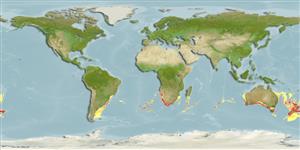Common names from other countries
分類 / Names
俗名 | 同種異名 | Catalog of Fishes(屬, 種) | ITIS | CoL | WoRMS | Cloffa
Teleostei >
Scombriformes (Mackerels)
鱸形目 (Mackerels) >
Centrolophidae (Medusafishes)
長鯧魚 (Medusafishes)
Etymology: Hyperoglyphe: Greek, hyper = over + Greek, glyphis = carved (Ref. 45335).
Environment: milieu / climate zone / depth range / distribution range
生態學
海洋 底中水層性; 深度上下限 40 - 1500 m (Ref. 52180), usually 260 - 490 m (Ref. 52180). 深水域; 19°S - 55°S, 67°W - 173°W
Southwest Atlantic: Argentina. Southeast Atlantic and Western Indian Ocean: South Africa. Southwest Pacific: New Zealand and Australia (including Western Australia).
西南大西洋: 阿根廷。 東南大西洋與西印度洋: 南非。 西南太平洋: 紐西蘭與澳洲 (包括西澳大利亞).
Length at first maturity / 大小 / 重量 / 年齡
Maturity: Lm 70.6, range 59 - ? cm
Max length : 140 cm TL 雄魚/尚未辨別雌雄; (Ref. 9563); common length : 60.0 cm TL 雄魚/尚未辨別雌雄; (Ref. 52180); 最大體重: 63.0 kg (Ref. 54802); 最大年齡: 15 年 (Ref. 9072)
背棘 (總數) : 7 - 8; 背的軟條 (總數) : 19 - 21; 臀棘: 3; 臀鰭軟條: 15 - 17. Uniformly dark to black.
全黑色到黑色的。
Most common over or near rocky areas at 100-300 m (Ref. 9258). Generally, blue eye remain close to the sea bed during the day and move up in the water column at night, following concentrations of food (Ref. 6390). The fish are found over rough ground and at the edges of canyons and steep drop-offs. Blue eye appear to prefer cold water as part of their general behavior (Ref. 6390). Juveniles inhabit surface waters, sometimes in association with floating debris (Ref. 6390). Feed primarily on the pelagic tunicate Pyrosoma atlantica which is found near the sea bed during the day but dispersed throughout the water column at night (Ref. 7129, 30454). They also feed on squid, mollusks and crustaceans (Ref. 30455, 30454) and fish ranging from small lanternfish (Myctophidae) to large fish such as gemfish (Rexea solandri). Juveniles consume small planktonic and sedentary organisms (Ref. 30456). Marketed fresh and frozen; exported to Japan for sashimi; eaten steamed, fried, broiled and baked (Ref. 9988).
最常見在岩石區上面或附近在 100-300 公尺.(參考文獻 9258) 通常,藍色的眼保持接近海床在白天期間而且移動在水團上面在晚上, 跟隨食物的集中.(參考文獻 6390) 魚被發現粗糙的底部之上而在峽谷與陡峭的海峭壁的邊緣。 藍色的眼似乎偏愛寒冷的水為他們的一般行為的一部份.(參考文獻 6390) 稚魚棲息於水表面, 有時伴隨著漂浮的殘礫.(參考文獻 6390) 主要捕食大洋性的有被膜的 Pyrosoma atlantica 是發現白天在海床附近但是在水團各處散佈了在晚上.(參考文獻 7129,30454) 他們也吃範圍從對大的魚例如帶鰆魚 ( Rexea solandri) 的小燈籠魚 (Myctophidae) 的烏賊,軟體動物與甲殼動物 (參考文獻 30455,30454) 與魚。 稚魚消費小的浮游生物與定棲的生物。 (參考文獻 30456) 在市場上銷售生鮮和冷凍; 輸出至日本用作生魚片; 清蒸, 油炸, 火烤了而且燒烤了.(參考文獻 9988)
In Australia, spawning appears to be correlated with water temperature and nutrient upwellings (Ref. 7129). It appears that mature fish move up the continental slope into shallow depths (320-400 m) and aggregate in specific grounds for spawning (Ref. 6390).
There is no information on the number of eggs blue eye produce nor on the egg and larval stages of their life history (Ref. 6390).西南大西洋: 阿根廷。 東南大西洋與西印度洋: 南非。 西南太平洋: 紐西蘭與澳洲 (包括西澳大利亞).
Haedrich, R.L., 1986. Stromateidae. p. 842-846. In M.M. Smith and P.C. Heemstra (eds.) Smiths' sea fishes. Springer-Verlag, Berlin. (Ref. 4410)
CITES (Ref. 128078)
Not Evaluated
人類使用
漁業: 商業性
工具
特別的報告
下載 XML
網路資源
Estimates based on models
Preferred temperature (Ref.
115969): 4.1 - 16.4, mean 7.5 (based on 485 cells).
Phylogenetic diversity index (Ref.
82804): PD
50 = 0.5156 [Uniqueness, from 0.5 = low to 2.0 = high].
Bayesian length-weight: a=0.00891 (0.00498 - 0.01595), b=3.10 (2.94 - 3.26), in cm Total Length, based on LWR estimates for this species & (Sub)family-body (Ref.
93245).
營養階層 (Ref.
69278): 4.0 ±0.57 se; based on food items.
回復力 (Ref.
120179): 中等的, 族群倍增時間最少 1.4 - 4.4年 (K=0.03-0.3; tm=5-7; tmax=15).
Prior r = 0.57, 95% CL = 0.38 - 0.86, Based on 3 data-limited stock assessments.
Fishing Vulnerability (Ref.
59153): Moderate to high vulnerability (51 of 100).
Climate Vulnerability (Ref.
125649): Moderate to high vulnerability (52 of 100).
